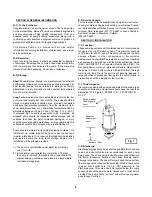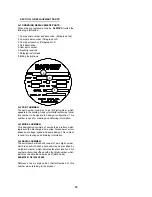
SECTION B: GENERAL INFORMATION
B-1) To the Purchaser:
Congratulations! You are the owner of one of the finest pumps
on the market today. Barnes
®
Pumps are products engineered
and manufactured of high quality components. Over one
hundred years of pump building experience along with a
continuing quality assurance program combine to produce a
pump which will stand up to the toughest applications.
This Barnes Pumps, Inc. manual will provide helpful
information concerning installation, maintenance, and proper
service guidelines.
B-2) Receiving:
Upon receiving the pump, it should be inspected for damage
or shortages. If damage has occurred, file a claim immediately
with the company that delivered the pump. If the manual is
removed from the packaging, do not lose or misplace.
B-3) Storage:
Short Term-
Barnes Pumps are manufactured for efficient
performance following short inoperative periods in storage. For
best results, pumps can be retained in storage, as factory
assembled, in a dry atmosphere with constant temperatures
for up to six (6) months.
Long Term-
Any length of time exceeding six (6) months, but
not more than twenty-four (24) months. The units should be
stored in a temperature controlled area, a roofed over walled
enclosure that provides protection from the elements (rain,
snow, wind-blown dust, etc.), and whose temperature can be
maintained b40 deg. F and +120 deg. F. (4.4 - 49°C)
If extended high humidity is expected to be a problem, all
exposed parts should be inspected before storage and all
surfaces that have the paint scratched, damaged, or worn
should be recoated with a water base, air dry enamel paint. All
surfaces should then be sprayed with a rust-inhibiting oil.
Pump should be stored in its original shipping container. On
initial start up, rotate impeller by hand to assure seal and
impeller rotate freely. If it is required that the pump be installed
and tested before the long term storage begins, such
installation will be allowed provided:
1.) The pump is not installed under water for more than
one (1) month.
2.) Immediately upon satisfactory completion of the test,
the pump is removed, thoroughly dried, repacked in the
original shipping container, and placed in a temperature
controlled storage area.
B-4) Service Centers:
For the location of the nearest Barnes Pumps Service Center,
check your Barnes Engineered catalog, your Barnes Pumps,
Inc. representative or Barnes Pumps, Inc. Service Department
in Piqua, Ohio, telephone (937) 778-8947 or Crane Pumps &
Systems Canada, in Brampton, Ontario,
(905) 457-6223.
SECTION C: INSTALLATION
C-1) Location:
These pumping units are self-contained and are recommended
for use in a sump, lift station or basin. The minimum sump pit
is 18" diameter and 30" deep. This pump is designed to pump
sewage, effluent, or other nonexplosive or noncorrosive
wastewater and shall
NOT
be installed in locations classified
as hazardous in accordance with the National Electrical Code
(NEC), ANSI/NFPA 70 or Canadian Electric Code (CEC). Do
Not pump heavy, viscous or abrasive materials. Never install
the pump in a trench, ditch or hole with a dirt bottom; the legs
will sink into the dirt and the suction will become plugged. If
large quantities of grease are flowing into the sump or tank, a
grease trap should be installed in the inlet line.
C-1.1 Submergence:
It is recommended that the pump be operated in the submerged
condition and the sump liquid level should never be less than
dimension "A" in Figure 1. SPRINT II, A = 3.5", SPRINT III,
A = 5.5"
C-2) Discharge:
Discharge piping should be as short as possible. Both a check
valve and a shut-off valve are recommended for each pump
being used. The check valve is used to prevent backflow into
the sump. Excessive backflow can cause flooding and/or
damage to the pump. The shut-off valve is used to stop system
flow during pump or check valve servicing. When a check valve
is used, drill a relief hole (.125 to .187" diameter) in the
discharge pipe. This hole should be located below the sump
cover and above the pump volute. Unless such a relief hole is
provided, the pump could "air lock" and will not pump water
even though it will run.
Recommended
Submergence
Level
Fig. 1
A
Minimum
Submergence
Level
Bottom of Feet
8
Summary of Contents for Barnes SPRINT II Series
Page 13: ...Fig 4 CONNECTION DIAGRAMS USED FOR DETERMINING WINDING RESISTANCE 13 ...
Page 21: ...Fig 15 SERIES SPRINT II 21 ...
Page 22: ...Fig 16 SERIES SPRINT II 22 ...
Page 25: ...SERIES SPRINT III Fig 17 25 ...
Page 26: ...SERIES SPRINT III Fig 18 26 ...
Page 28: ...NOTES 28 ...









































